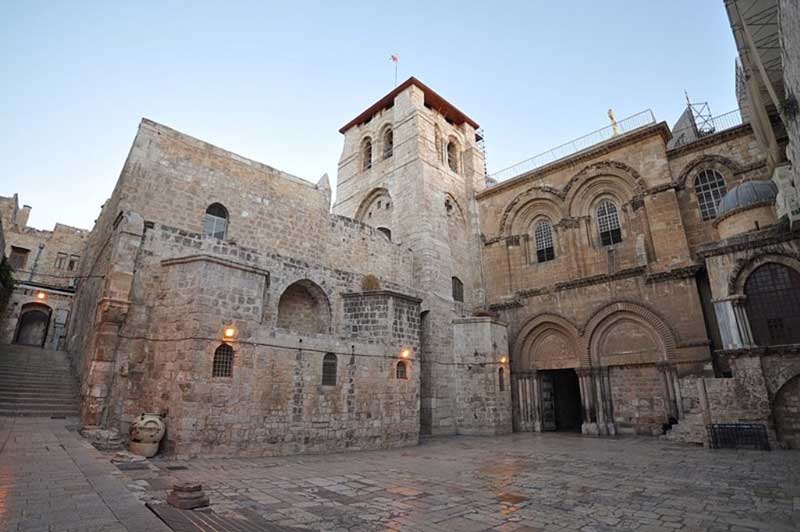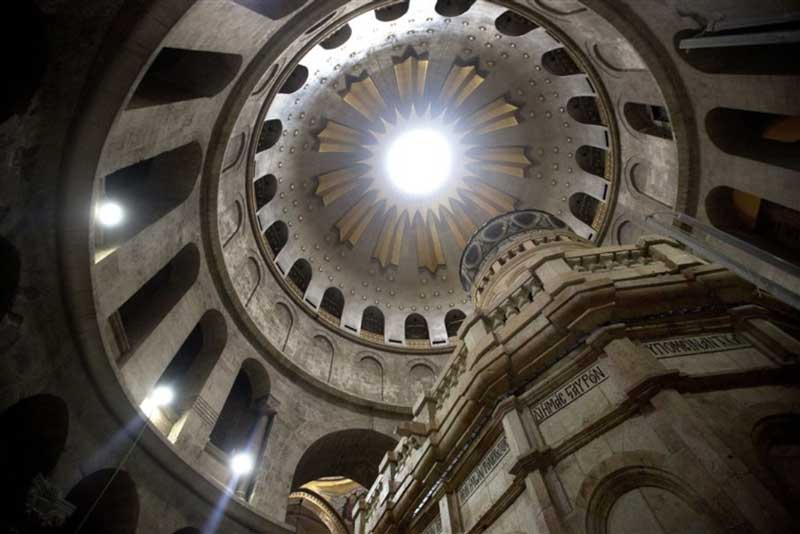
According to the Christian traditions dating back to at least the fourth century, the Church of the Holy Sepulchre in Jerusalem contains the two most holy sites in Christianity. They are, the site where Jesus was crucified and the empty tomb, where he is said to have been buried and resurrected. The site of crucifixion is known as Golgotha or Calvary, while the empty tomb, enclosed by a 19th-century shrine, is called the Aedicule.

At the beginning, Constantine the Great first built a church on the spot where the Church of the Holy Sepulchre is now situated, in the northwest quarter of the Old City of Jerusalem. It is said that, Constantine embraced Christianity after he saw the vision of a cross in the sky in 312 and ordered to pull down the pagan temple of Jupiter or Venus built by Hadrian, located on the spot, where three crosses were found, leading the Romans to believe that they had found Calvary. After the demolition of the temple and removal of the debris, a rock-cut tomb was found, which was identified as the tomb of Jesus, around which the shrine was built.
The church was consecrated on 13 September 335, but the building was destroyed by a fire in May of 614 AD, when Khosrau II of the Sassanid Empire invaded Jerusalem and captured the True Cross. The building suffered severe damage from consecutive earthquakes in 746 and in the ninth century and also suffered a fire in 841. However, it was completely destroyed by the Calipoh al-Hakim Bi-Amr in about 1009, to be restored by the Byzantine emperor Constantine IX Monomachus in 1084. After that, the Crusaders in the 12th century carried out a general rebuilding of the church and since that time, the building was frequently repaired, restored and remodeled and the present church dates mainly from 1810.

There is a stairway inside the church entrance that leads up to Golgotha or Calvary, said to be the site of Jesus’ crucifixion, which is the most extravagantly decorated part of the church. There is another stairway that serves as the exit from this place and leads down to the ambulatory. The Calvary is comprised of two chapels, one is Greek Orthodox and the other is Catholic, each with its own altar. The altar of the Greek Orthodox chapel is situated over the rock of Calvary, the 12th Station of the Cross. The rock is kept under protective glass on both sides of the altar and can be touched through a special hole in the floor beneath the altar.

In between the Catholic and Greek altars, there is a statue of Mary with 18th-century bust marks the 13th Station of the Cross. The Chapel of Adam is located on the ground floor, just underneath the Golgotha chapel and the Museum of the Greek Orthodox Patriarchate is situated behind the Chapel of Adam, containing lots of relics, which include a 12th-century crystal mitre, a type of ceremonial headdress of bishops and certain abbots, alleged to have once held a fragment of the Holy Cross.

The Stone of Anointing, believed to be the spot where the body of Jesus was prepared for burial, by Joseph of Arimathea, is located just inside the entrance to the church and is also known as the Stone of Unction. However, this tradition is comparatively new and possibly started since the crusader era, probably in 1288. The present stone was added only in the 1810 reconstruction. The modern three-part mosaic along the wall depicts the anointing of the body of Jesus.
The Aedicule, a small chapel housing the Holy Sepulchre, consists of two rooms. One of them houses the Angel’s Stone, believed to be a fragment of the stone that sealed the tomb of Jesus. The other room is the tomb of Jesus. A marble plaque was placed on the tomb in the 14th century, to protect it from further damage caused by flocks of pilgrims.


Today, the left-hand entrance of the church serves as the only entrance, as the right doorway has long since been bricked up. The courtyard facing the entrance to the church is known as the parvis and on the north of the parvis, stands the blue-domed Chapel of the Franks, a Roman Catholic Crusader chapel, which once provided the exclusive access to Calvary.
A group of three chapels borders the parvis on its west side. The 12th-century Crusader bell tower that lost its upper level in a 1545 collapse and also lost another two in 1745, is located to the left of the entrance, just south of the Rotunda.